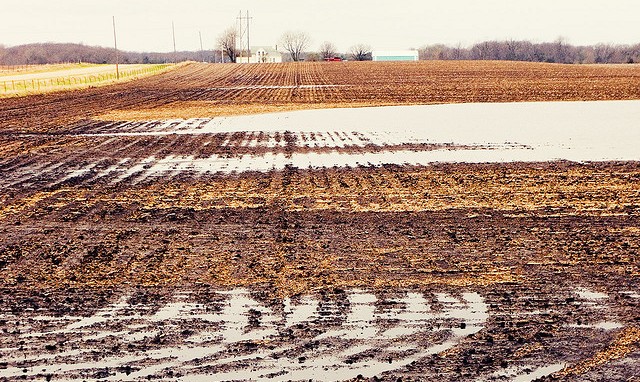
Farmer Fact of Life: You can't get seed into a field like this one in Iowa, and if you did it wouldn't come up. And most of the fields in 20 states look like this. (Photo by David Morris/Flickr)
While the nation largely ignores the developing, historic flood of the Mississippi River and its tributaries, it is totally oblivious to the rising threat of ordinary — well. perhaps not ordinary, but certainly less dramatic — rain to current and future harvests in the nation’s breadbasket. The fact that the Corn Belt is soaking wet, where it is not completely inundated, does not bode well for food prices, or for the food supply, in the US or the world.
As we reported here a month ago (“World, US Food Supplies Faltering, Prices Rising”), the US Department of Agriculture predicted a “very tight situation” this fall with regard to the supply of, and demand for, corn and soybeans. First of all, when a USDA spokesperson uses the words “very tight situation” on the record, it’s the equivalent of a normal person running from the room with his hair on fire. Secondly, the prediction rested on two assumptions: that US farmers were about to plant the largest acreage in recent history, and that they would enjoy “normal” yields from all that acreage.
The Mississippi flood — perhaps just the blowing of the levee at Birds Point, Missouri — has by itself trashed those assumptions. But wait there’s more. The entire Corn Belt, from the Dakotas (actually, from the Canadian Prairies, which is more the Wheat Suspenders) and Nebraska to Indiana and Ohio, is experiencing a cold and wet spring. The fields may not be under water, but they’re wet, and you cannot sow wet, cold ground.
The window for getting seed in the ground in time for it to make it to maturity before the fall frosts is rapidly closing. The drop-dead date for most planting varies slightly from state to state, but is generally around the middle of May. A week from now. As of the end of last week, according to the USDA’s weekly planting progress report, 87% of the corn crop in the 18 high-production states is not yet in the ground. Last year at the same time, two-thirds of the fields had been planted.
Although Wolf Blitzer and Katie Couric have yet to notice, local and farm publications across the region are dominated by the threat. A brief survey:
Michigan (yesterday): Heavy spring rain delays planting, food prices could rise.
North Dakota (May 3) ND crop planting still hampered by wet spring.
Illinois (April 28): Producers Face Decisions as Planting Delay Lengthens.
Indiana (May4): As the wet spring continues to delay planting in Indiana, grain farmers are faced with tough decisions about their intended tillage operations.
We would all be well advised to pay attention, between royal weddings and terrorist assassinations, to this increasingly inconvenient fact. Food prices around the world are alarmingly high and are already destabilizing countries. In poor countries, they are killing people; in the the affluent industrial countries, they are just reaching the level of consumer awareness.
Continuing shortfalls in production, which are certain as industrial agriculture continues to collapse on itself and climate change continues to bear down on the farms of the world, will mean that in the near future all of us will be worried about not only the price of food, but its availability.
[For updates on this and other stories, check out the Editor’s Log.]